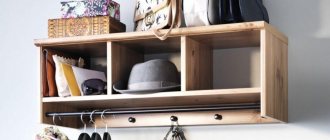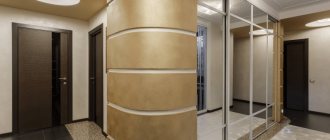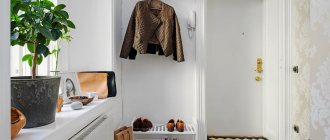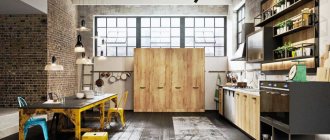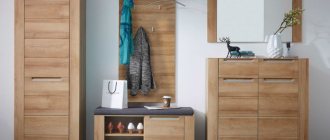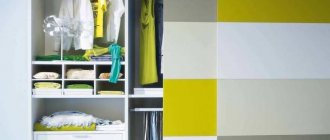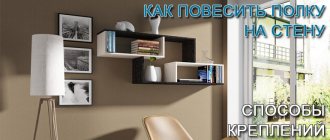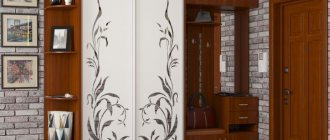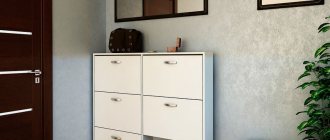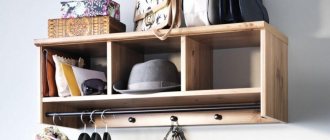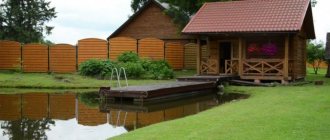Opening the door and crossing the threshold of the apartment, the first thing a person does is put his outerwear and shoes back in their places. To prevent wardrobe items from lying in the aisle and disturbing your household, you should take care of purchasing a convenient and compact storage system. A special cabinet for shoes in the hallway is selected in accordance with the dimensions of the room and the style of the interior, so it is important to know about the types of shoe racks and the rules for choosing them. This category of furniture is offered by manufacturers in a wide variety; there is always the best option for any budget.
Variety of models for the hallway
A shoe cabinet that is correctly selected in size and style will not only increase the service life of shoes, shoes and boots, but will also save free space in the corridor, especially if its area is small . The following shoe rack models are common:
- floor;
- hanging;
- open;
- closed;
- straight;
- corner.
The choice of shoe cabinet model directly depends on the needs of the buyer and the parameters of the room.
Floor-standing
Floor cabinets in the hallway for shoes are the most common among buyers. They are an ordinary small cabinet with several compartments, with or without doors. You can choose deep, high, low or narrow options. Some models have seats and compartments for small items. Distinctive features of floor options:
- availability of additional components;
- ideal compatibility with any interior;
- affordable price.
Floor stands have a significant drawback - the need to constantly ventilate shoes.
The most comfortable shoe racks of this type are considered to be overshoes - you can put boots, other high shoes, sneakers and shoes in them. Often they choose a shoe cabinet in a hallway with a sofa. Such furniture does not take up much space even in a small room.
Hanging
This type of cabinet is hung on the wall, they have different shapes and configuration options, but the essence is the same for all - the drawers are secured with hooks, and the shoes are placed in a vertical position. Hanging furniture is rarely chosen for hallways - it is more suitable for dressing rooms. For example, the owners do not want to install a large wardrobe and replace it with a wall-mounted cabinet. Hanging shoe racks have several more features:
- constant ventilation;
- no need to purchase additional furniture;
- the perfect design solution.
As a rule, shoe compartments are fixed at an angle, this makes placement more convenient. But at the same time, it is more difficult to remove sand or accumulated dust from them. Therefore, buyers prefer shallow, medium-sized models.
Open
Open structures are several shelves connected to each other by two sidewalls. They do not exceed 1 meter in height. More often they prefer models up to 50 cm wide. Open cabinets can be presented in the following variations:
- up to 5 shelves;
- shelves on the side, closed or open;
- Instead of shelves, plastic shovels are made for more convenient shoe storage.
The most common materials for making open cabinets for hallways are plastic and wicker.
Closed
Closed cabinets are small cabinets or chests of drawers for shoes. In size they can reach 220 cm in height, up to 120 cm in width and up to 55 cm in depth. There are several different heights:
- low - up to 55 cm, with one shelf;
- medium - up to 120 cm, with several shelves;
- high - up to 250 cm.
The downside is that tall cabinets are more expensive than their smaller open counterparts, but you can hide clutter behind the doors. Such shoe racks are more suitable for small hallways. Can be combined with other pieces of furniture.
Rules for placing a narrow shoe cabinet in the hallway, the nuances of choosing it
Direct
These shoe cabinets look like small rectangular wide cabinets. The most common model is with several horizontal compartments and folding doors (to save space). Suitable for medium-sized corridors.
Divided into 2 categories:
- Budget. The cabinets are low - up to 120 cm in height with 2-3 compartments for shoes.
- Expensive. Height up to 250 cm, narrow or medium in width - up to 60 cm.
Will fit perfectly into the classic interior of the apartment. When purchasing a closed cabinet, be sure to have holes for ventilation, otherwise the shoes will not dry out.
Corner
Such a bedside table, depending on the size and configuration, can be used to store shoes, umbrellas, keys, telephone, gloves and other small things. Compared to other types of cabinets, these options have many advantages:
- Suitable for even the smallest corners in the hallway. For example, if there is an empty wall in front of the front door, you can easily find a model that fits perfectly under it.
- Options with beveled or rounded facades significantly reduce the likelihood of injury.
- The internal space allows for storing a large number of different things that do not find room in the drawers located in other cabinets.
The only drawback of the corner cabinet is the inability to use the folding mechanism for the entire internal volume.
Features of a hanging cabinet in the corridor - types of fastening
The modern furniture market offers two types of cabinets: floor-mounted and wall-mounted.
Mounted models are a rather interesting option. Their peculiarity is that they not only meet all functional requirements - they are a place to store things and shoes, but also save space in the hallway. The cabinet is mounted on the wall, and therefore there is free space underneath it, which can be used, for example, to place slippers or everyday shoes.
In addition, cleaning a room with hanging furniture is much easier.
The design of a hanging cabinet can be very unusual, and the very external lightness of the design visually expands the room, making it more spacious, which is especially valuable for small hallways.
Depending on the characteristics of the walls of the room themselves, as well as the weight of the bedside table, they are secured in the following ways:
- On anchor bolts. This type of fastening is quite reliable, the bolts can withstand fairly massive structures, it is suitable for both concrete and brick walls, its only drawback is its unesthetic appearance.
- For furniture canopies. The most common mounting method, which is applicable to almost any type of wall. The weight that one canopy can hold is more than one hundred kilograms.
- For bolts and angles. This type of installation is used in the case of thin partitions.
Height options and equipment
It is most convenient to consider options for the height and configuration of shoe cabinets using the example of closed structures . They are distinguished by the most diverse range and fit perfectly into almost any interior. Three standard types of cabinet heights:
- low;
- average;
- tall.
There are also several types of components available:
- hanger;
- mirror;
- banquette;
- seat;
- sofa
The configuration directly affects the final cost of the furniture.
Low
The height of this model does not exceed 55 cm; usually the furniture is equipped with 1 long shelf or 2 small ones on one half; the second has a compartment for storing umbrellas, gloves or shoe care products. Additionally, for more convenient use, the manufacturer adds:
- a hard seat, newspapers and keys are usually placed on it;
- a soft seat, which is convenient to sit on to take off or put on shoes (the seats are solid or with an attached stand for small accessories);
- a small sofa of increased comfort.
A low cabinet is an ideal option for small hallways and those owners who do not need a lot of space to store shoes.
Average
The cabinets are medium in height - up to 120 cm. This is enough to accommodate the shoes of 3-4 people. The depth is also small - up to 35 cm. This category provides for additional compartments for storing gloves or umbrellas.
You can choose models with shelves for small items and keys. To make more efficient use of space, such models are equipped with mirrors or several clothes hangers are attached to them. This is an ideal option for maximizing the use of room space. It is the cabinets of medium height that are in steady demand among buyers.
High
Models with a height of 150 to 250 cm are designed for large hallways. If a closet was previously installed in the corridor, the shoe cabinet is selected to be the same height. There are options with pull-out shelves, which are convenient if the apartment has a small amount of space to the wall - 30–40 cm.
In models with a height of 250 cm, not all shelves can be reached. High sections are used to store out-of-season or weekend shoes. A very convenient solution if there is not enough or no dedicated space for other shoes.
Closed options are good because the doors easily hide all things, and a person passing by the structure will not touch the protruding toes of shoes. The second advantage is the aesthetic side, since such models look much more original compared to open ones. However, such structures cost more (from 4,500 rubles), and shoes take longer to dry due to the inability to ventilate the space.
Advantages of a roll-out cabinet, its dimensions and contents
dimensions
The overall dimensions of shoe cabinets in the hallway directly depend on the parameters of the space allocated for furniture. It is important to choose the right design that will be spacious and at the same time occupy a minimum of free space. The division is carried out into several categories:
- Open – there are no closing doors, shoes are always in sight. Most often presented in medium sizes - up to 120 cm.
- Closed - doors swing open, or drawers with shoes slide out. Often designs are complemented with soft seats. Closed models are suitable for apartments with animals. There are low and high. Standard sizes are from 50 to 250 cm.
- Slim - designs are narrow and tall. Racks are usually located from top to bottom, one can store up to three pairs of shoes. Purchased for rooms with small square footage. Standard options are shallow and high - 30 cm depth and up to 250 cm height.
- A rotating stand with spacers is an option suitable for those who have a large number of shoes. Standard height is up to 90 cm, depth is up to 45 cm.
As a rule, the height and length of a shoe rack are directly proportional to the depth and width, that is, high elements are usually of minimal depth (up to 35 cm) and sufficient width (up to 55–60 cm). Low cabinets are traditionally made wide to accommodate a larger number of shoes - 70–80 cm. The least popular are low (up to 50 cm) and shallow (up to 30 cm) shoe racks, since they can fit a minimum of pairs, they are inconvenient to use - sometimes placed inside shoes fall out.
If the hallway area is too small, shallow furniture is suitable - from 13 to 30 cm.
Open Closed Rotating Stand Slim
Additional items
Modern cabinets can be equipped with additional open shelves, which are much smaller in size than others. They are designed to store magazines and newspapers that the owner took out of the mailbox on the way to the apartment.
Some products require the presence of a free plane on the cabinet. Family photos or key holders are placed here. For example, an option where a soft bench is connected to the main compartments of the shelves allows you to place various accessories on the surface.
Don’t forget, if the hallway is too small, you should abandon empty, unused surfaces. It is better to give preference to functional products in which each compartment is designed for storage. In this way you can significantly save space and fit as many shoes as possible.
Manufacturing materials
Shoe cabinets are mainly made from several types of materials:
- Tree. The material ranks first in frequency of use for furniture making. Wooden cabinets have an attractive appearance and will fit into any interior. They are characterized by massiveness, therefore they are chosen for large corridors. Pine is most often used, since the material is considered the easiest to process. To extend the service life of the cabinet, it is recommended to coat the surface with a protective varnish.
- Plastic. The most budget material for making cabinets. It is lightweight and practical; to maintain it, you only need to wipe the furniture with a damp cloth once a week. However, such designs are not suitable for luxurious interiors and large areas. In addition, the product breaks easily due to minimal resistance to mechanical stress.
- Metal. Such models are considered the most durable and expensive. The big disadvantage is susceptibility to corrosion. To protect the product, it is coated with protective paint. The color options are unlimited, so owners can choose a cabinet that perfectly matches the style of the hallway.
- Chipboard. The material is easy to process, so you can make furniture of any shape and size. Bedside tables are lightweight - usually up to 5 kg, and their cost is affordable. The downside is the use of hazardous components in manufacturing, so it is recommended to study the composition before purchasing.
- MDF. Furniture boards are made from medium-density wood fibers. During the production process they are pressed and given the desired shape. Compared to chipboard, the material is characterized by a higher density, so such cabinets are less susceptible to swelling due to humidity.
- Vine. This is also wood, the furniture from which turns out to be sophisticated and unusual. The rods are intertwined into bizarre shapes. The big advantage is low cost. The furniture is environmentally friendly and can be cleaned with a regular damp cloth.
- Rattan. This is a material artificially created from synthetic fibers. When making furniture, plastic tapes are intertwined with each other in various variations. The material is not the most durable and does not withstand high loads. But the furniture does not dry out and does not require special care.
Advantages of side tables, their features and varieties
The strength, reliability and durability of the assembled structure depend on the choice of raw materials. Often, preference is given to one material or another with an eye to interior design.
Wood Plastic
Metal
Chipboard MDF
Vine Rattan
Location rules
To use the cabinet for its intended purpose, it must be placed correctly in the hallway. Products 40 cm deep are difficult to place near the door, so the best option is to install them in a corner or on the wall opposite the entrance.
Placing a piece of furniture near the door will increase the speed of taking off and putting on shoes and will be appropriate if the cabinet is not too deep. A bench located on the surface of the model suggests the presence of free space for sitting. It is more advisable to place such a product away from the front door.
If there is a narrow passage, use a hanging cabinet that will be placed above foot level and will not cover part of the space. Open models can be installed almost anywhere: due to the lack of doors, they are quickly accessible and do not require additional space for access.
Types of opening mechanism
The most common 4 types of mechanisms for opening cabinets for shoes:
- Hinged doors with fixed shelves. The cabinet compartments fold down and contain shelves with shoes. Plus - they take up little space, minus - they are poorly ventilated.
- Swing. Furniture doors open outward and are located vertically due to fastenings. Plus - the mechanism is convenient for opening, minus - they require additional free space.
- Sliding. There are two doors, one of which moves to the side when opened. The most inconvenient model due to the way the doors slide, but it takes up little space.
- Pull-out drawers. Inside there are shoes standing on the bottom; when opened, the drawers slide out towards themselves. Placement requires a lot of space, but such models are easy to use.
The cost of the cabinets depends on the door opening mechanism. The most expensive ones are swing and folding ones.
Folding Hinged Sliding Drawers
Style and color
A variety of furniture options allows you to choose a cabinet in a wide variety of colors, even for small-sized corridors. The product is purchased depending on the interior style:
- For rooms designed in a classic style, a medium-sized model is suitable. The ideal option is a white cabinet, because it is this kind of furniture that reflects light and visually enlarges the space. Also, wooden products in noble brown shades, from the lightest to wenge, will fit into such an interior.
- A model similar in size to a small closet will fit into a hallway made in a rustic style (country or Provence). The colors of the wood should be natural, and the surface should be coated with impregnation that does not hide the natural texture.
- A loft-style corridor is ideally complemented by low or high and wide products. Popular color options are bamboo, dark blue, dark brown, black.
- Modern styles are characterized by a lack of pronounced decor and simple forms. Therefore, an interior in a minimalist or hi-tech style will organically complement plain products with a glossy surface.
The most popular are wooden cabinets with a natural protective coating, always wide, up to 120 cm high, as well as closed-type options with retractable drawers.
Classic style
Country Provence Loft
Modern
Unusual and non-standard models
For the most part, a shoe rack for a hallway is furniture that is placed on the floor. But there are several varieties that are hung on vertical surfaces: walls, doors. For example, the PitStop wall-mounted shoe rack. The shelves in it are folding, each divided into three cells. One shelf - two drawers. If desired, they can be hung one above the other or placed horizontally.
Wall-mounted shoe rack in the hallway with folding shelves
There is a shoe rack made of wire that can be hung on any vertical surface. This could be the same wall, the door of a closet, pantry, dressing room, etc. They are a great replacement for a shoe organizer. They are, of course, more expensive, but they are more convenient to use, the shoes don’t wrinkle as much and hold their shape better. A couple of such options can be seen in the photo below.
A couple of mounted models
Hanging shoe shelves can be placed in a narrow partition, between the wall and the cabinet, on the side of the cabinet. This will help organize the space of a small hallway.
Rotating models
Among non-standard models, you can also remember racks and rotating shelves. If there are a lot of shoes, there is not much space to place them, but there is a free corner, you can install a rack with rotating shelves. The corners are difficult to fully use, and a rotating shelf will fit there perfectly. And it fits a lot of shoes.
A rotating shoe rack is a good idea for optimal use of space
For small hallways in small apartments there is an even more interesting option: a combined hallway with a shelf for shoes. This furniture is double sided. On one side there are hangers for clothes, on the other there are shelves for shoes. The entire structure rotates around its axis. You need to hang your coat - turn it to the side with the hooks. I need to put my shoes on - they turned the shelves towards me.
Rotating mini-hallway with built-in shoe rack
Such furniture can probably be placed in the corner. It will take up little space. Actually, an interesting idea. Although, you can also find a shoe rack with a hanger or mirror. But they are stationary and do not use space so efficiently.
Shoe rack in the hallway: photos of interesting models
There are several models that are difficult to classify. Interesting idea, shape, material. We will place them in this section. Maybe this is where your shoe rack for the hallway is waiting for you.
Idea for storing rubber boots
Shoe bench
An easy way to turn an open model into a closed one
Shoe rack for the hallway in the loft style Another creative option If there are a lot of shoes...
Glass and wood - why not... This model makes your head spin Plastic shoe racks are also closed
The originality of this design is unrivaled In the style of tradition
In this version it looks more like a couch...
For quick access... you can, by the way, put it in a closet
Useful tips for choosing
To make it easier to choose bedside tables for shoes in the hallway, you can use these useful tips:
- if the room is small and square, models up to 100 cm wide, up to 35 cm deep, up to 250 cm high are suitable, and the best option would be tall, narrow white furniture;
- a standard-sized hallway will be organically combined with cabinets up to 120 cm high; you can hang coat hooks on top or allocate space for a mirror;
- for a room that is large in all respects, it is not recommended to purchase narrow furniture with sliding doors - there will be a lot of free space, and the cabinet will look out of place;
- if the corridor is narrow, it is necessary to take up a third of the length with furniture, and you should pay attention to shallow versions of the products.
A shoe cabinet in the hallway is the easiest way to create a convenient storage system for sneakers and shoes. When choosing, it is important to be guided by the size of the room and the style in which it is decorated, having previously selected a suitable place for placing this furniture.
For a small square hallway For a standard one
For a large person in a narrow corridor
Photo of hanging wall cabinets in the hallway interior
<
>
A hanging bedside table in the hallway is an option for compact and roomy furniture. If you choose it correctly, it will delight the owners of the apartment with its functionality for a long time and will become a beautiful element of the interior.
